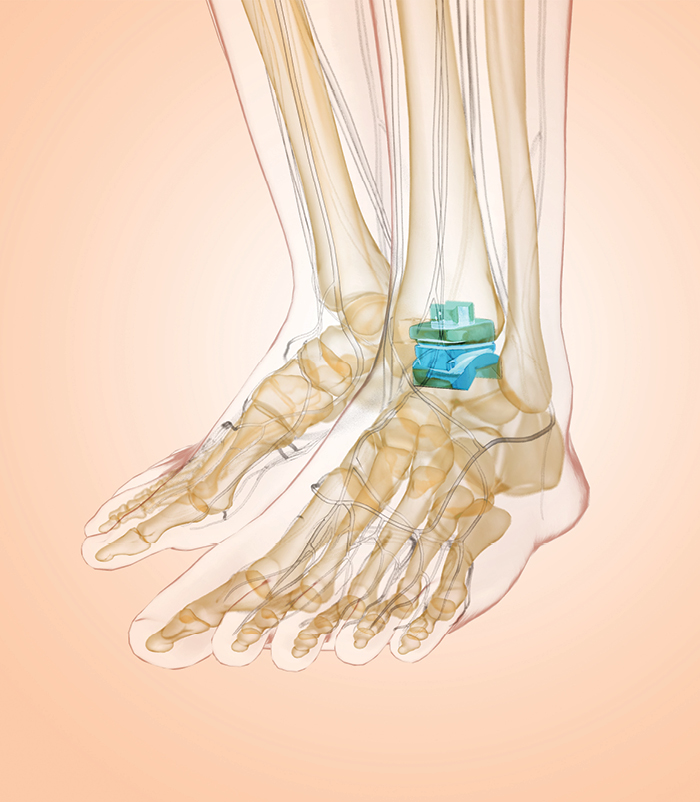
_Sorin Siegler
Siegler is a professor of mechanical engineering and mechanics in the College of Engineering.

_Brian Garvey
Garvey (BS/MS ’12) is senior vice president of restor3d.
The explosion in the popularity of joint replacement surgery over the past two decades is one of the biggest stories in the world of health care. Yet despite this meteoric rise, it seems likely that the years to come will see these intensive, yet life-changing, surgeries grow even more popular.
According to the American Academy of Orthopedic Surgeons (AAOS), the number of total knee replacement surgeries performed each year in America is expected to increase by nearly 700 percent — to more than 3.5 million procedures annually — over the course of the next decade, while total hip replacements are projected to grow 200 percent. Advances in medical technology and improved recovery times are helping to propel this pace, but perhaps the biggest reason so many people are opting for these procedures is the simple fact that they work.
In fact, they work very, very well.
Ninety percent of knee replacement recipients report a “dramatic” reduction in pain, according to the AAOS, while those who undergo hip replacements often regain 80 percent of the total strength of their hip after just two months of rehabilitation. There are broad societal benefits as well: While knee replacement costs around $21,000, savings in the form of increased earnings and greater productivity total nearly $40,000. And each patient who undergoes a knee replacement will realize a lifetime net benefit of anywhere from $10,000 to $30,000, in addition to greater quality of life.
It is hardly a stretch, then, to say that modern medical technology has made hip and knee procedures not only cost-effective, but downright commonplace. The medical world’s near perfection of these surgeries means that the millions who will undergo them each year ultimately live happier, fuller lives — free of pain, and free to be active.
Unfortunately, the same cannot be said for the millions afflicted with arthritis of the ankle or who have suffered a traumatic ankle injury. While total knee replacements have a success rate of nearly 96 percent, the rate for ankle replacements is a comparatively woeful 78 percent.
On the surface, that disparity may not seem all that striking. But in human terms, it certainly is. Given the expense, pain and rehabilitation time that comes with any joint replacement, it’s hardly surprising that many patients, when informed that the failure rate for current ankle replacements is nearly 25 percent, opt for an ankle fusion instead.
That, despite the fact that fusion surgery means they will lose flexibility in their ankle joint forever.
“It’s very sad, to be honest,” says Brian Garvey (BS/MS ’12), who is CEO of Narberth, Pennsylvania-based Kinos Medical. “There are a lot of ankle fusions performed each year — three times as many fusions as ankle replacements, actually. And the reality is, that’s the situation only because the technology for ankle replacements isn’t there yet. The anatomy is a bit more difficult, and there simply hasn’t been good, quality engineering that addresses the unique challenges of the ankle anatomy.”
But now, that long-sought quality engineering has finally arrived, Garvey says, thanks to the pioneering work of a research team led by Sorin Siegler, a professor of mechanical engineering and mechanics in Drexel’s College of Engineering.
Garvey’s healthcare startup, Kinos Medical, formally launched in 2017 to develop and commercialize artificial ankle implants based on Siegler’s insights about the true shape and design of ankle bones.
Siegler began a deep investigation into the unique, somewhat complicated anatomy of the human ankle joint nearly a decade ago. By using modern imaging methods such as MRIs and CT scans and creating 3D renderings of the scans on a computer, Siegler was able to reproduce highly accurate models of ankle bones. It was while creating a cast of the talus bone — one of three bones that make up the ankle, and one that forms the crucially important “pivot” on which the joint moves — that Siegler made a startling and in some ways historic discovery.
Simply put, one bone scan revealed that almost everything the medical community knew about the ankle was wrong.
A Seven-Decades-Old Error
In 1952, a University of California researcher and celebrated pioneer in the biomechanics of locomotion by the name of Verne Thompson Inman published one of his seminal works, “The Joints of the Ankle.” In it, Inman concluded that the ankle joint was “fixed,” meaning that it allowed for movement along a single plane; second, he said that the talus — so central to the ankle’s functionality — was conical in shape, and that the top of that cone faced the inside of the foot.
Given Inman’s reputation at the time, his word carried quite a bit of weight, and for a period of roughly 70 years, neither of his conclusions were challenged — until Siegler took a closer look using modern computers and imaging methods.
As Siegler’s research showed, Inman was wrong on two counts. The ankle joint is actually not fixed. Rather, the joint allows for movement along a flat plane as well as a more side-to-side angle that allows humans to land on either the outside or inside of the foot. And because Inman had built his model of the talus based on his belief that the joint was fixed, that meant his calculations for the shape and orientation of the talus were wrong as well.
When Siegler recalculated and recalibrated for the actual functionality of the ankle, he discovered that the talus in actuality faces the outside of the foot; beyond that, Inman’s conception of the shape of the talus was wrong as well.

StepS_IN_The_Right_Direction
Kinos Medical’s aim is to develop “next-generation technologies to bring orthopedics into the 21st century.” The ankle replacement device startup won the Clinical Biomechanics Award from the International Society of Biomechanics in 2013, rounded up $1 million in seed funding to get up and running, and has won continuing financial support from the Coulter-Drexel Translational Research Partnership as well as from Steep & Deep Ventures in Malvern, Pennsylvania, and from Ben Franklin Technology Partners of Philadelphia.
Siegler had spotted a fundamental anatomical error — one that has underpinned (and undermined) all work focused on the ankle, including ankle replacement devices, for more than a half century.
“I was looking at the geometrical features of the ankle, and the features as I saw them were almost directly contradictory to the prevailing wisdom — directly opposed to what has been known and published about the ankle in the academic literature,” Siegler explains.
“What was understood and taught for decades turned out to be not the exact case,” concurs Alberto Leardini of the Istituto Ortopedico Rizzol in Italy, who is helping Siegler test new artificial ankle designs based on Siegler’s research. “And this probably might have affected the performance of the current prostheses.”
The question, then, is obvious: how could such a fundamental error have gone unchecked for so long?
To hear Siegler tell it, it happens all the time.
“Many concepts in the world of science are allowed to exist and be very wrong for the longest time until somebody sees it,” Sorin says matter of factly. “The reality is, as new technologies come and new methods come up, you can start exploring things and looking at things in a different way.”
Better Technology, Better Results
The challenge for Garvey now is to take Siegler’s ankle models and turn them into a profitable company.
Joining him in the effort is Siegler himself, who serves as the startup’s chief technology officer; Dr. Keith Wapner, clinical professor of orthopaedic surgery at the University of Pennsylvania, who serves as the company’s medical director; and Drexel alumnus and company director William Rhoda, an accomplished investor in medical technologies with more than 50 medical device patents to his name.
Rhoda, who also serves as president and CEO of Collegeville, Pennsylvania-based OT Medical LLC, got his start in the medical device industry while completing his co-op at Drexel, and later hired Garvey as a co-op student when Garvey was studying mechanical engineering at Drexel. It was Rhoda who ultimately recommended Garvey for the role of CEO at Kinos, and so it goes without saying that the mentor has confidence in his apprentice. He also has confidence in the product, even as his experience in medical device development tells him there remain several boxes to be checked and hurdles overcome.
“First, there’s the FDA part — and that’s a hurdle, but at the very least, it’s a known hurdle,” Rhoda says. “The commercialization part is a whole different animal. There’s going to be a little bit of resistance to anything total-ankle-related just, in general, because of the bad history associated with them. …The gold standard is still fusion, but if you consider the amount of hips and knees that are being done every year, imagine being told, ‘Oh, we’re going to fuse your ankle.’ It just doesn’t seem acceptable.”
“I was looking at the geometrical features of the ankle, and the features as I saw them were almost directly contradictory to the prevailing wisdom — directly opposed to what has been known and published about the ankle in the academic literature.”
—SORIN SIEGLER
Garvey, too, understands that challenges lie ahead. Even still, Garvey believes the opportunity is there to make a major splash — and potentially revolutionize the total ankle replacement market.
“The devices that are on the market today are basically built and based on research that was conducted in the 1950s and 1960s, and some really aren’t based on technology at all,” Garvey explains. “A lot of them are just built around how engineering in this area has evolved over time. So when we looked at Sorin’s research and how that research lined up as compared to the other products out there, it was almost a no-brainer.”
In fact, what Kinos intends to offer goes far beyond the hardware of the ankle itself. Siegler and Garvey’s ultimate goal is to perfectly match their hardware to the anatomy of individual patients using cutting-edge imaging technology. They say that one of their products will be the first “patient specific” total ankle replacement system to ever hit the market.
This level of personalization would allow surgeons to significantly reduce the amount of healthy bone removed when placing the implant in a patient — a time-consuming, difficult task that poses potential complications.
“Because we can personalize this, it will allow us to reduce the time required for [the surgery],” says Siegler. “If you would ever see one of these procedures … it actually takes hours. It’s very hard. It’s very tedious. But with our personalized solutions, we can cut that time maybe by as much as half.”
Their design also promises to dramatically improve the success rate of the implants, while allowing younger patients access to early surgical intervention.
“We have the legitimate opportunity to become a market leader in the ankle replacement world,” Garvey says. “Now, that may take 10 or 15 years to fully achieve, but at least here in the United States, we can be the undeniable market leader both in breadth of technology and in market share.”
Kathie Jordan, for one, shares Garvey’s optimism. As director of Drexel’s Coulter-Drexel Translational Research Partnership, an early-stage funding program established at Drexel by a gift from the Wallace H. Coulter Foundation, she works with her team to identify research and technologies with great potential in the marketplace.
Kinos, she says, is in many ways a perfect fit for the foundation, and its target market.
“This is exactly the kind of project that, historically, the Coulter program looks for,” Jordan says. “It’s about an engineering technology that truly meets a medical need. Because in terms of ankle replacements, they are just not working.”
Though she acknowledges that the market for total ankle replacements is fairly small, she — like the Kinos team – believes that if Kinos can show that their proposed methods improve success rates, patients who may have previously opted for fusion would, instead, opt for total ankle replacement.
That would represent a sea change in orthopaedics.
“Obviously, if you were told there’s a new ankle joint on the market that actually fails at the same low rate as the knee or hip, and then you’re told your other option is to have your ankle fused — and that you’ll never be able to ski again, or run again — I know which one I’d take,” she says. “At the same time, we are seeing that the reimbursement rate for ankle joints is increasing. So that means the value proposition here may eventually be much greater, and that makes a big difference.”
The potential is there. But plenty of hard work remains.
Going forward, Garvey says, his aim over the next few years is to continue to develop and perfect the company’s product line — and, at the same time, continue to educate surgeons about both the limitations of current products and the potential value of that being offered by Kinos.
Once they have the opportunity to compare, Garvey says, he’s confident they’ll buy in. That won’t just help Kinos, he says. It could help millions of patients, too.
“We’re going to be putting out a product that is going to be a full step ahead of the other players in the market,” Garvey says. “Right now, those companies are offering technology that, for the most part, is already as good as it can possibly be. But ours, at its full potential, will be substantially better.


